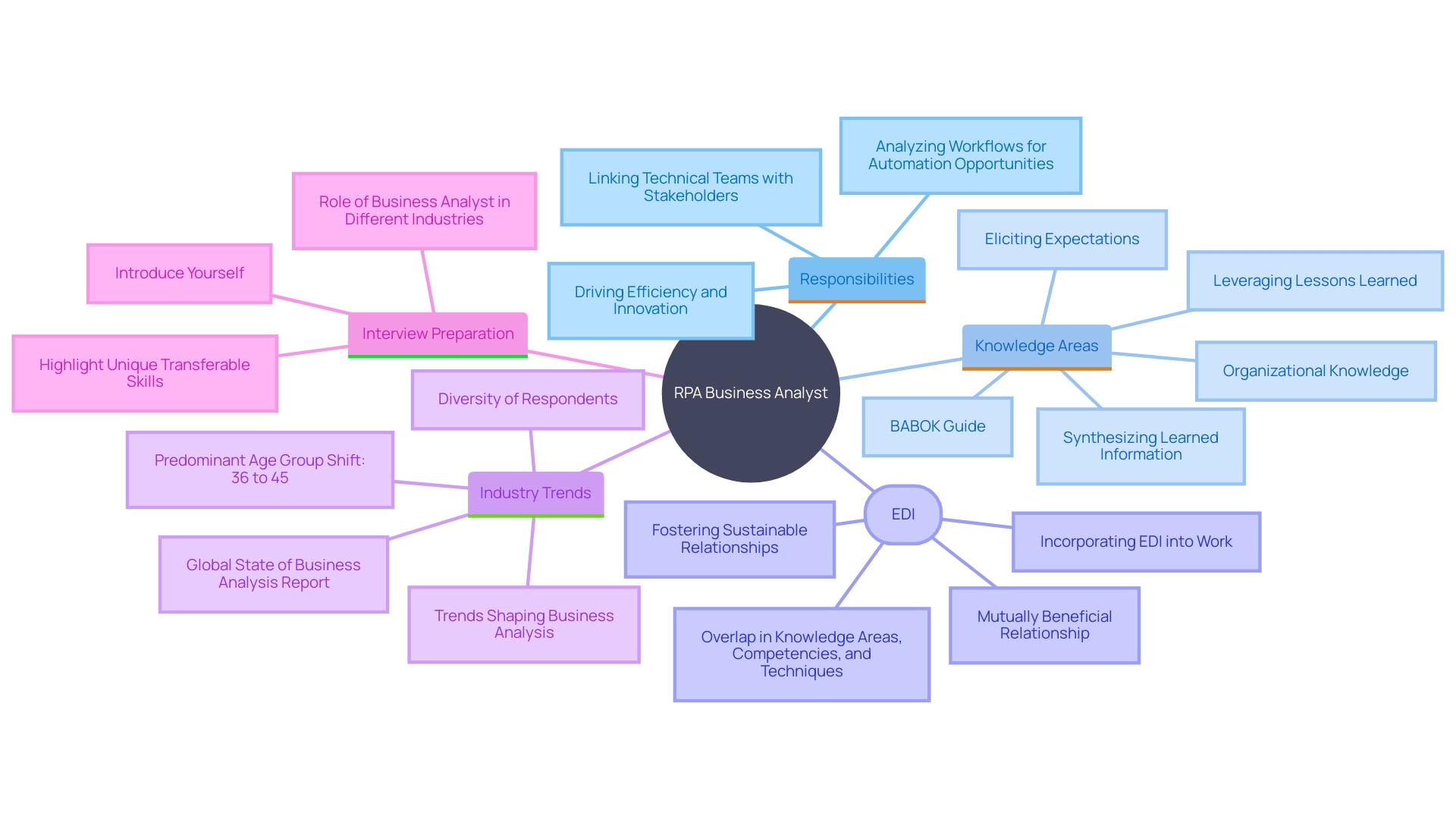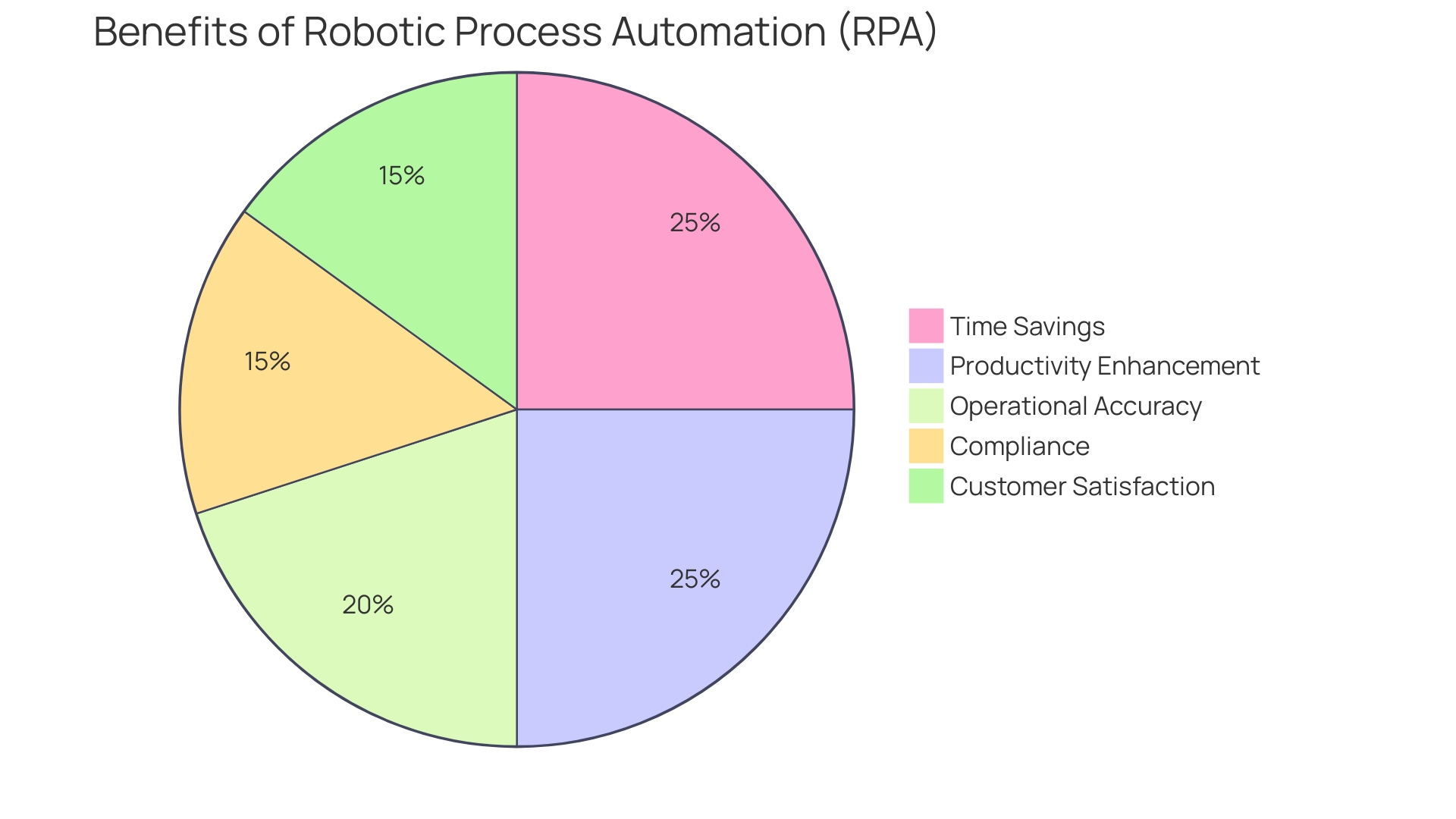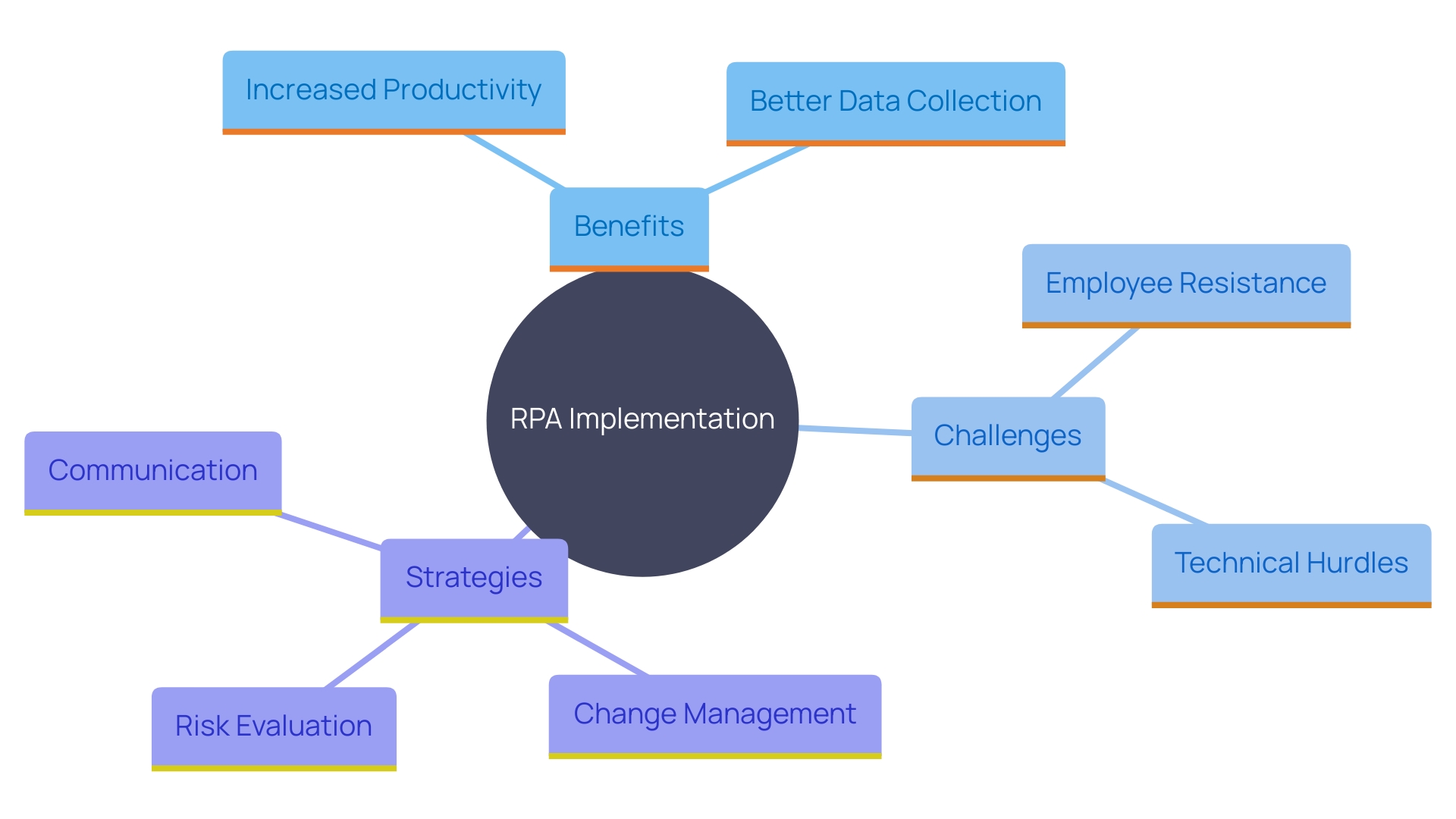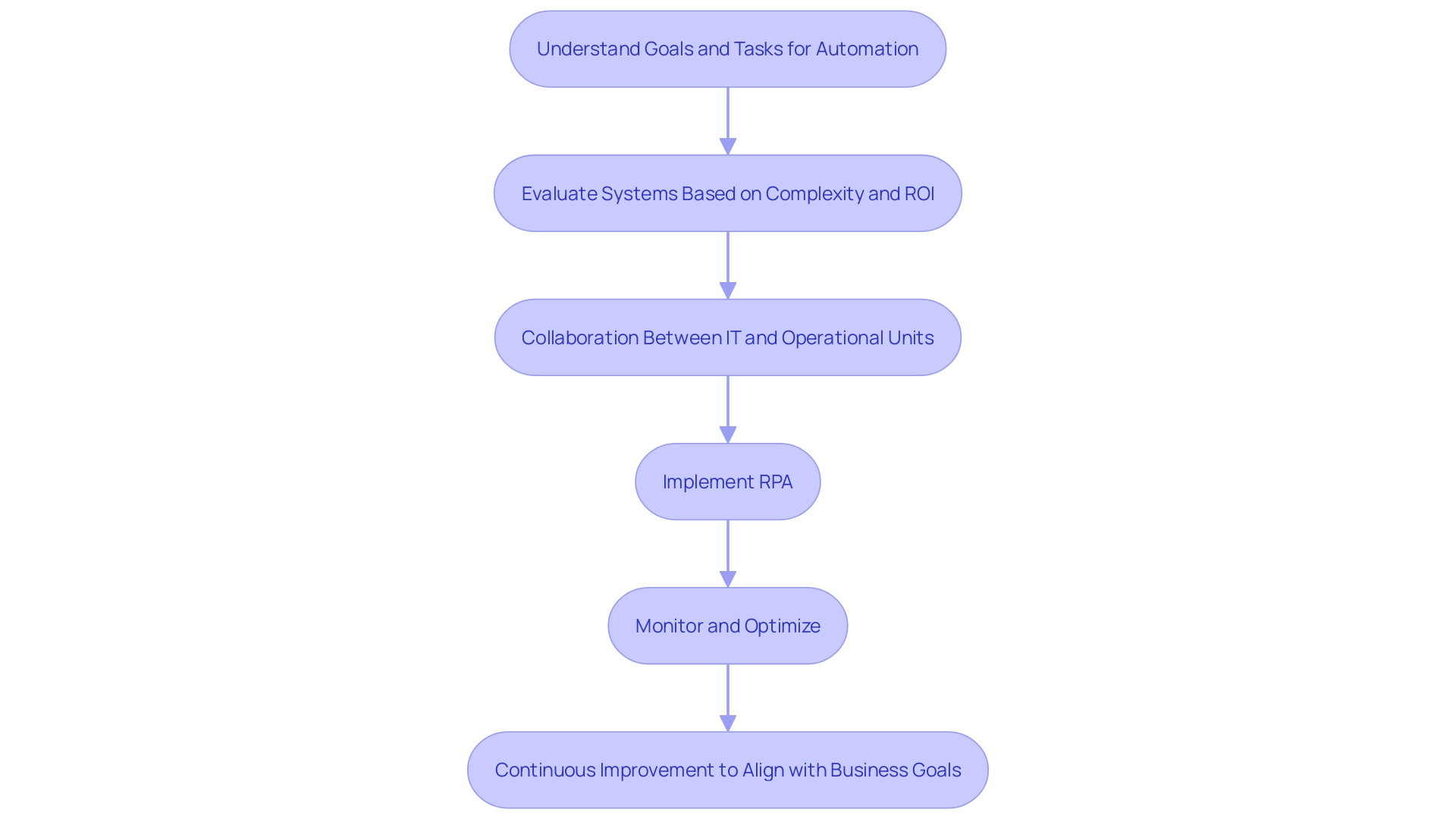Introduction
Robotic Process Automation (RPA) Business Analysts are pivotal in bridging the gap between technology and business, playing a crucial role in deploying and managing RPA systems. These professionals ensure that automation initiatives align seamlessly with an organization’s strategic objectives by meticulously analyzing workflows and identifying automation opportunities. This leads to streamlined processes, reduced operational costs, and enhanced efficiency.
As highlighted in the Global State of Business Analysis Report, the evolving role of RPA Business Analysts underscores the growing importance and maturity of this profession. Companies like Transcom exemplify the successful integration of RPA Business Analysts in driving innovation and operational excellence through automation. As businesses navigate the complexities of modern environments, the expertise of RPA Business Analysts remains essential for sustainable growth and competitive advantage.
Understanding the Role of RPA Business Analysts
‘RPA Business Analysts are essential in the implementation and oversight of robotic workflow systems.’. They serve as the essential link between technical teams and organizational stakeholders, ensuring that RPA initiatives are perfectly aligned with the entity’s strategic goals. By meticulously analyzing workflows, they pinpoint opportunities for automation, which leads to streamlined operations, reduced operational costs, and enhanced efficiency.
‘Their expertise in understanding organizational requirements and process intricacies is vital for developing effective RPA strategies.’. ‘According to the Global State of Analysis Report, which surveyed over 4,400 professionals from 165 countries, the role of analysts is evolving, with a significant shift in the predominant age group of respondents from 25-35 to 36-45, highlighting the growing importance and maturity of the profession.’.
For instance, companies like Transcom have effectively utilized RPA Business Analysts to incorporate digital tools and platforms, applied insights, and operational excellence through automation. This approach not only improves efficiency but also fosters innovation by transforming custom technology incubations into commercial solutions.
As the sector continues to evolve, the role of RPA Analysts will remain critical in navigating the complexities of contemporary environments and driving sustainable growth. ‘Their ability to bridge the gap between technology and commerce is not just a necessity but a strategic advantage.’.

Key Benefits of RPA in Business Efficiency
Robotic Process Automation (RPA) offers transformative benefits that drastically elevate business efficiency. Leveraging RPA, companies can automate repetitive and rule-based tasks such as data entry and document processing, significantly reducing the time required to complete these tasks. This shift allows employees to redirect their focus towards higher-value activities, boosting productivity and enhancing job satisfaction.
The impact of RPA on operational accuracy and compliance cannot be overstated. By minimizing human errors typically associated with manual processes, RPA ensures a higher level of precision and adherence to regulatory standards. For instance, RobosizeME’s collaboration with Louvre Hotels Group exemplifies the potential of RPA; the mechanization of rate code maintenance saved the hotel chain an impressive 574 hours monthly, showcasing the immense efficiency gains achievable through mechanized processes.
Moreover, mechanization speeds up turnaround times, thereby enhancing customer satisfaction and competitive edge. A McKinsey study emphasizes this by forecasting that companies will dedicate over 25% of their capital to mechanization solutions in the coming years. This trend highlights the strategic importance of RPA in maintaining a competitive edge in the market.
RPA’s benefits extend beyond large enterprises to small and medium-sized enterprises (SMEs), which often hesitate to adopt automation due to perceived high costs and complexity. However, the real-world successes in various industries illustrate that RPA can be a game-changer, promoting operational efficiency and resource optimization across the board. As companies continue to embrace RPA, they stand to achieve not only improved efficiency but also substantial gains in productivity and customer satisfaction.

Challenges and Considerations in RPA Implementation
Implementing RPA offers substantial benefits but can also introduce several challenges. A significant obstacle is the resistance from employees who fear job displacement, underscoring the necessity for robust change management strategies. Clear communication and proper training are vital to ease these concerns. For instance, integrating RPA with existing systems can be complex, requiring a thorough assessment to ensure the technology is secure, appropriate, and compliant with necessary approvals.
A case study from the healthcare sector illustrates this well. The Digital Service Team conducts an initial assessment to determine if a new digital technology is already in use or if it meets security and compliance standards. This approach helps mitigate technical hurdles and ensures that the infrastructure supports RPA initiatives.
Moreover, insights from industry specialists such as David Truloff highlight the significance of risk evaluation in preserving the quality and safety of operations and systems. Organizations need to categorize, review, and monitor their operations consistently. This foundational step is crucial before adopting any advanced technologies, including RPA.
Statistics show that businesses using automated technologies can monitor more workers more of the time, expanding the scope of data collection and informed decision-making. While this can lead to higher productivity, it also highlights the need for balancing technological advancements with ethical considerations and employee collaboration.
In conclusion, overcoming these challenges requires a strategic approach that combines technical assessments, risk management, and strong communication to ensure a smooth and effective RPA implementation.

Strategies for Successful RPA Integration
Effective incorporation of RPA demands a strategic method, starting with a clear comprehension of goals and specific tasks for automation. Recognizing systems based on complexity and potential ROI is essential. For instance, automating manual, repetitive tasks often yields the most significant quick wins. As one expert notes, “Map the procedure and identify the stakeholders and systems involved.”. Once you have a list of possible candidates, compare complexity and estimated ROI.” This evaluation should encompass standards such as frequency of automated executions, potential monetary value, and peak demand periods.
Continuous monitoring and optimization are essential to maintain efficiency. For example, by assessing the time saved through mechanization compared to the manual process, organizations can quantify the benefits effectively. ‘Real-world applications, like the checkout-free store powered by Zippin technology in Dublin Airport, highlight the practical benefits of automated systems, such as eliminating queues and enhancing customer convenience.’.
Furthermore, promoting a culture of teamwork between IT and operational units is essential. This collaborative approach not only drives innovation but also helps in identifying new opportunities for automation. As the landscape of RPA and Intelligent Automation evolves, staying ahead requires a commitment to continuous improvement and strategic alignment with business goals.

Conclusion
RPA Business Analysts play a crucial role in the successful deployment and management of robotic process automation systems, acting as a vital link between technology and business. Their ability to analyze workflows and identify automation opportunities leads to improved efficiency, reduced costs, and strategic alignment with organizational goals. As highlighted by industry trends, the importance of these professionals is only set to grow, emphasizing the need for businesses to leverage their expertise in navigating modern complexities.
The transformative benefits of RPA cannot be overstated. By automating repetitive tasks, organizations can significantly enhance productivity and accuracy while minimizing human error. This not only leads to better compliance with regulatory standards but also fosters a more satisfied workforce, as employees can concentrate on higher-value activities.
The successful implementation of RPA, as illustrated by various case studies, showcases its potential to deliver substantial efficiency gains across all types of enterprises.
However, the journey toward successful RPA integration is not without challenges. Resistance from employees, technical complexities, and the necessity for robust change management strategies must be addressed to ensure a smooth transition. Organizations are encouraged to adopt a strategic approach that involves thorough assessments, consistent monitoring, and fostering collaboration between IT and business units.
This proactive mindset is essential for overcoming obstacles and reaping the full benefits of RPA.
In summary, the integration of RPA is not merely a technological upgrade; it represents a fundamental shift in how businesses operate. By embracing the insights and strategies outlined, organizations can position themselves for sustainable growth and a competitive edge in an increasingly automated future.

